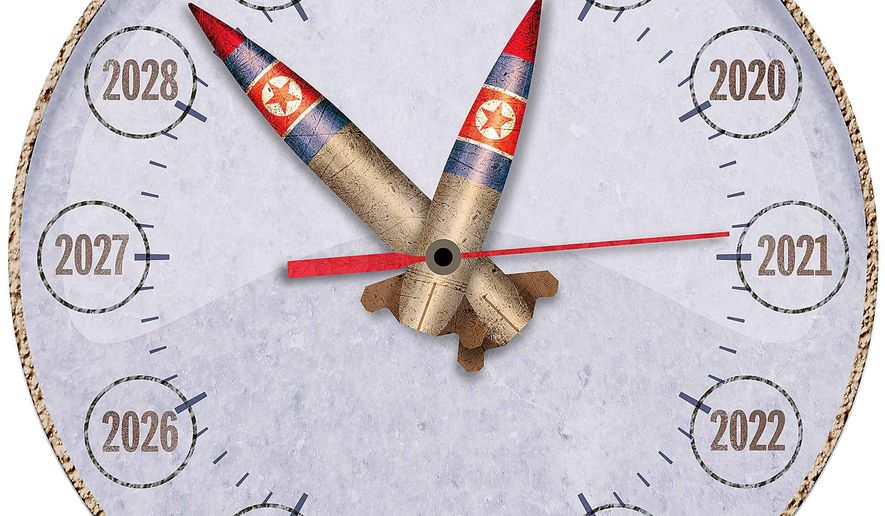OPINION:
In the fives months since President Donald Trump and North Korean leader Kim Jong-un met for a historic rendezvous in Singapore, progress in U.S.-North Korea nuclear negotiations has been fleeting. While Secretary of State Mike Pompeo continues to engage with his North Korean counterparts, and while the White House is reportedly planning another summit next year, much of Washington is highly skeptical Pyongyang is interested in denuclearization.
The lack of progress, however, is not dissuading Mr. Trump from quitting diplomacy. Addressing the news media on Nov. 7, Mr. Trump told reporters that he is willing to continue the give-and-take, even if denuclearization may turn out to be a fruitless endeavor. “[W]e’re not in any rush at all,” the president remarked. “There’s no rush whatsoever.”
Mr. Trump is right: There is no rush. Indeed, the surest way to destroy diplomacy with North Korea is to accelerate the process when the other side has made it clear that an incremental, step-by-step approach is the way concessions will be made.
Yet even as Mr. Trump puts diplomacy first, he needs to be crystal clear with himself as to how far Mr. Kim is willing to go. To be frank, the odds of Mr. Kim dismantling his entire nuclear weapons program to the last ounce of uranium on Washington’s schedule is at best unlikely. Not a single country since the dawn of the atomic age has invested a significant portion of its small economy to build what could be as many as 60 nuclear warheads, only to trade the arsenal away in return for financial, economic and political commitments. It is highly implausible that North Korea, a small, weak and poor state wedged between Asia’s great powers, will be the first.
While North Korea’s relinquishing of its nuclear warheads, warhead and fuel-production facilities, and long-range missile capability is the absolute ideal scenario, the ideal is not a prerequisite for safety and security for the American people.
Throughout the Cold War, the United States confronted two nuclear adversaries simultaneously in the Soviet Union and Communist China, countries whose collective military, economic and political power far exceeded anything North Korea would possibly attain today. Yet the United States, through the nurturing of security relationships with friendly powers, a vast nuclear weapons arsenal of its own, and military-to-military crisis management and mitigation, was able to defend the U.S. homeland and American interests in strategically vital parts of the world.
The full weight, power and professionalism of the U.S. armed forces deterred Moscow and Beijing from using nuclear weapons in an offensive or even defensive capacity. There is no evidence Mr. Kim — a man fixated on his regime’s preservation and his place atop that regime — is any different than the earlier strongmen who had control of the nuclear bomb. Everything Mr. Kim has shown over his first six years in power leads to the opposite conclusion: He is interested in injecting wealth into his country and staying in power for as long as possible.
Although Mr. Trump should not give up on denuclearization as a long-term goal, he must disabuse himself of the notion that Pyongyang will part ways with its life insurance policy in the current environment. Mr. Kim is a highly cautious leader suspicious of all outsiders, including the Chinese; while he may be young, he also has a good grasp of history about what can happen to American adversaries who don’t have the luxury of the nuclear card. The experiences of Iraq’s Saddam Hussein and Libya’s Moammar Gadhafi are never far from the young North Korean dictator’s mind.
The real and most important immediate goal is not disarming Pyongyang, but rather securing peace in order to prevent a war.
To his enormous credit, South Korean President Moon Jae-in has been spending nearly a year breaking the ice with his North Korean counterparts through high-stakes personal diplomacy — the kind Mr. Trump himself has embraced with the North Korean dictator. In a span of about six months, Mr. Moon and Mr. Kim have held three summits, authorized their governments to probe whether a diplomatic rapprochement is possible, and produced two communiques that, while not officially binding, have lifted the veil of war and confrontation that was hovering over both Koreas a year earlier.
The summit meeting in Pyongyang last month produced a highly significant demilitarization agreement which, if fully implemented, will greatly enhance mutual communication between the North and South Korean militaries and reduce security incidents along the Demilitarized Zone — all the while establishing a mechanism for continued dialogue among Korean officials at the working level.
Improved relations between the Koreas make a military conflagration far less likely, and thus serve U.S. national security interests in East Asia. Ultimately for the United States, it is peace on the Korean Peninsula that truly matters.
In the weeks and months to come, the Trump administration will hit a number of roadblocks as it continues to prod the North Koreans into denuclearizing. There may come a time when the diplomatic process grinds to a complete halt, but if it does, President Trump does not need to fall back on the chest-thumping of his more hawkish national security advisers. As the United States has been able to do throughout the nuclear era, the Trump administration can dust off deterrence and dialogue, a combination that will keep the American people safe.
In the meantime, the White House should provide its South Korean ally with the leeway to continue its drive in pursuit of a more peaceful and predictable Korean Peninsula — a transformation that would be just as important to Washington as it would be to Seoul.
• Daniel DePetris is a fellow at Defense Priorities.




Please read our comment policy before commenting.